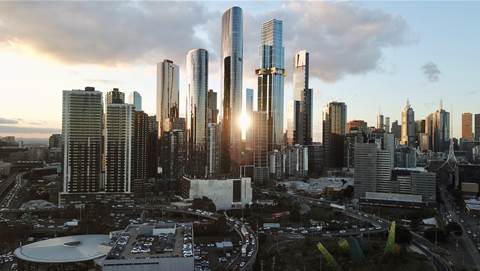NBN Co has set a low bar for fibre-to-the-node users to qualify for a last-mile full fibre upgrade, while also revealing the anticipated full cost-per-premises of an upgraded line.

The company provided significant clarity around the $2.9 billion upgrade to half of the FTTN footprint that it unveiled with its latest corporate plan last month.
Unlike in its enterprise business, where free fibre upgrades are conditional on usage and other contractual commitments, NBN Co indicated it would set a much lower bar to qualify residential users for the so-called “on demand fibre upgrade” scheme.
“To be clear there’s been some misunderstanding I saw in the media that we’re expecting everybody to buy gigabit services. We’re not,” Rue said.
“We’re expecting everybody to buy higher speed services than they [have] today.”
Chief customer officer Brad Whitcomb said an order for a single speed tier above their current plan could qualify a residential customer.
“The customer would need to order a speed that they could not achieve on their existing technology so that’s the basic premise of this,” Whitcomb said.
“If someone was on FTTN rated at 60Mbps and they’re on a NBN50 plan but would prefer to be on NBN100, then they would be a candidate for an on demand model because we couldn’t deliver them the service that they wished on the current network.”
NBN Co also suggested that in cases where FTTN chronically underperforms - and other remediations fail - a residence may be able to qualify for an upgrade in order to hit 50Mbps speeds.
“If the copper just isnt sufficient, but we know they’ve got good in-home wiring, then they would be a candidate, subject to whether we have built enough fibre into that area or not,” Whitcomb said.
Whitcomb suggested that NBN Co would not set a minimum contract length or period of time to stay on a higher plan to qualify for a fibre upgrade.
He said that retailers would have the power to set such terms but that they “wouldn’t be NBN Co’s decision” or NBN-driven.
However, he did note that NBN Co’s thinking is “if someone’s currently on a service, and they order a higher speed service, that they would stay on that higher speed” once receiving the new fibre lead-in.
Under questioning, NBN Co executives conceded they were concerned the offer could be gamed, and that they would need to carefully consider rules around when to enable an upgraded customer to drop back down on their plan speeds, such as for financial hardship reasons.
“The exact measures we put in place, we haven’t written up yet but the broad answer is the desire here is to have the ability for consumers to on-demand order more than they can get today,” Rue said.
“Now in terms of gaming of the system - and I’m not suggesting someone dropping down because of income is gaming the system - but gaming of the system is certainly something we’d have to make sure does not occur.
“We dont want to also put constraints on people to deal with what might be a small number of edge cases. So we’ll have to put those rules in place.
“But on a broad basis, both the intent from an economic point of view but also the intent from the purpose of our company to build digital capability is to give as many consumers as possible the ability to order higher speeds than they get today.”
Calculating a cost-per-premises
In the dying minutes before Senate Estimates hearings closed at 11pm AEDT on Thursday, significant headway was made in understanding the revised cost-per-premises (or CPP) of an upgraded FTTN customer.
This was a hot topic on internet forums and social media immediately after the late September announcement of the upgrade project.
The $2.9 billion allocated to the FTTN-to-FTTP upgrade covers the deployment of fibre closer to 2 million premises, and then the cost of 200,000 fibre lead-ins.
“What the $2.9 billion gives you is - there’s a little bit of home wiring but let’s ignore that for the moment - basically the buildout of 2 million premises’ fibre from the node to outside the street, and then there is the build of around about 200,000 lead-ins for people who choose higher speed tiers,” Rue confirmed.
“That’s the capital [expenditure] in the 2.9 billion.”
An important extraction last night was the cost of each fibre lead-in.
“We have modelled $1500 per lead-in,” Rue said.
“That’s based on what we have historically incurred.
“We would obviously look to do better than that, but that’s been the history of supporting CPP you would see.”
That number allows for some back-of-envelope calculations on the total CPP of an upgraded residential premises:
- At $1500 a lead-in, with 200,000 lead-ins, that accounts for $300 million of the $2.9 billion.
- That leaves $2.6 billion for the deployment of fibre from the node to the street, for 2 million premises - a cost of about $1300 per premises.
- That means the cost of upgrading a premises from FTTN to FTTP is around $2800.
- There is likely to be a small margin of error here, as Rue said some in-home wiring upgrades are also embedded in the $2.9 billion.
- The CPP for FTTN/B came in at $2330 in the latest corporate plan. Removing the cost of the FTTB portion here is challenging, though it is a relatively small portion.
- A premises originally given FTTN/B and later upgraded to FTTP would have a cumulative CPP of $2330 + $2800: $5130
- By contrast, a premises given FTTP outright cost $4395.
- It’s likely NBN Co would argue that adding the original FTTN/B CPP and the FTTP upgrade costs is inaccurate, however, because they say the FTTN network will have paid for itself, and that years of FTTN revenue is what made the FTTP upgrade possible.
- The addition of revenue means it may be more accurate to consider the FTTN CPP and upgrade CPP as separate investments, albeit into the same residential premises.
iTnews will update this if it receives additional information from NBN Co.
The lucky 2 million
There is still less clarity on exactly where the 2 million homes - or which half of the FTTN footprint - will get fibre deployed from the node to the street.
NBN Co executives indicated late last night that there are a range of factors at play in their decision-making.
“We’re looking at multiple factors of where we will roll out fibre deeper into the FTTN network,” chief operations officer Kathrine Dyer said.
“We’re looking at potential take-up; underlying aspects of the network so pit-and-pipe and passive components available; we are looking at least construction costs to make sure that we use scarce capital as efficiently as possible; and we’re also looking at ways ... to make sure that we’re using resources effectively.”
Rue also said that NBN Co would “look to over-index in regional areas”, with around half of the 2 million FTTN premises to be in regional areas.
In addition, the company will take into account state-based investment plans, where possible - suggesting states may be able to influence the upgrades.
“Understanding strategies of state governments is also important as well,” Rue said.
“For example, if we knew an innovation zone was going to be built, that may influence where we see demand from that point of view.”
Rue said that more criteria could be set once a consultation process with retail service providers wraps up.
“We want to talk to retailers as well to get the retailer view on all of this,” he said.
“What we plan to do is we’ll look to determine that criteria in the first quarter of next calendar year.


















.png&h=141&w=208&c=1&s=1)

